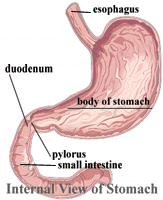Components of the Digestive System
Oral cavity- Mechanical processing, moistening, mixing
with salivary secretions. Mouth breaks down food, moistens food,
starts the break down of starch, glycogen.
Salivary Glands- Secretion of lubricating fluid
containing enzymes that breakdown carbohydrates.
Esophagus- Transport of material to the stomach.
Liver- Secretion of bile (important for lipid
digestion), storage of nutrients and vitamins, many other vital
functions.
Gallbladder- Storage and concentration of bile (the
liver).
Stomach- Chemical breakdown of material through acid
and enzymatic attack.
Pancreas- Exocrine cells secrete buffers and digestive
enzymes. Endocrine cells secrete hormones.
Small Intestine- Provides suitable environment for
enzymatic digestion and absorption of nutrients, vitamins, and
ions. There, the breakdown of major food molecules takes place,
lubrication of the food pathway is provided, and control of the
acidity of the food released into the small intestines by the
stomach is controlled.
Large Intestine- Dehydration and Compaction of
indigestible materials for elimination.
Rectum- Storage of wastes. Distension (stretching the
rectum) triggers the defecation reflex that rids the body of
undigested and unabsorbed residues.


